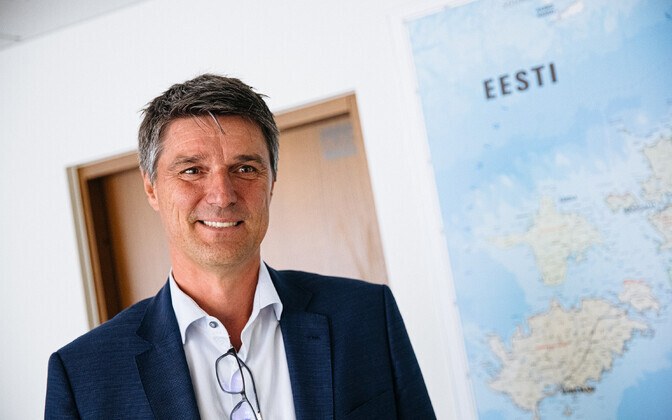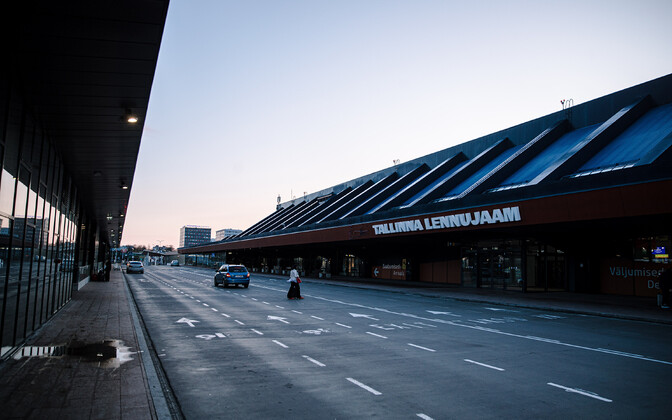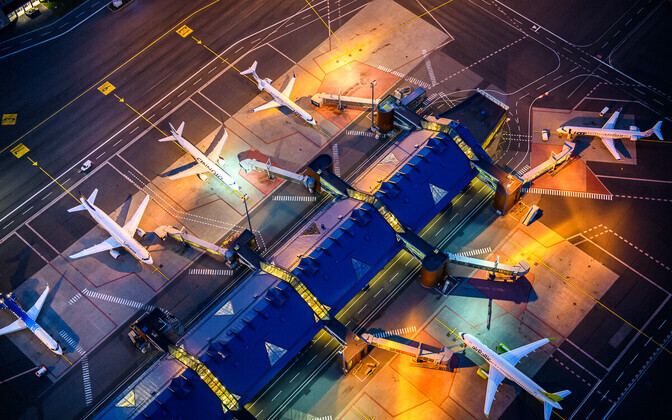
A colleague of mine complained that it’s difficult to get a good night’s sleep in Mustamäe, because of the planes. In fact, many airports prohibit night flights. A recent noise study showed that hundreds of houses must endure excessive din. What can an airport do?
Air traffic controllers determine which side of Tallinn Airport to land on, the city side or the Rae municipality side. The decision is primarily influenced by the direction of the wind.
Noise reduction is problematic indeed. Nearly half of the flights on today’s schedule are late. The morning traffic hour in Tallinn begins around 6 a.m., or even slightly earlier. The last planes land at 1 a.m., so many flights take place while people sleep.
What happened to the plan of moving Tallinn Airport away from the city?
This is not an option really, as substantial investments have already been made in its current location. As a small nation Estonia can’t afford to build another major airport somewhere else.
Let’s talk about destinations, it’s mind-blowing to see how many flights there are from Riga Airport or Helsinki Airport…
Unfortunately, this is the case. In aviation, the logic is to take a radius of two hours by car from the airport and assess how many people are in the area. Let’s say that in the south of Tallinn we reach Tartu and in the east we reach Narva. Finns don’t actually fly to Tallinn from the north. So one million people live in the so-called operational area of Tallinn Airport. Riga airport, on the other hand, can count on 3-4 million people, and Vilnius as many as 5 million, if Belarus is included. The border with Belarus is practically closed at the moment.

Geographically, we are indeed in a place where there are fewer potential passengers; and in aviation, it’s about the number of passengers. It’s really the same in everywhere. You don’t build a fuel station where there is no cars.
What effect do EU state aid regulations have on the capacity of airports? Are Frankfurt Airport and Tallinn Airport comparable in status?
The state aid rules are rather similar for all airports. There is a certain limit below which the rules are looser, but Tallinn airport is well above that.
The state can really save the day. For example, the government assists our rescue and security services, which is permissible under state aid standards because it is a national obligation and responsibility. But at the moment, this assistance is insufficient. Simply put, the expenses of rescue and security are far higher. This is where the direct demand to reduce airport fees comes from. Because security costs were negative last year, we are currently negotiating with the owner. Let’s wait and see what happens. We would prefer not to raise airport fees. Many airlines are outraged, and we are actually jeopardizing some direct flights to Estonia.
Also, there are provincial airports, which are still completely regional in nature, so the government does not fund all of these expenses and investments. If the Estonian government covered these costs, airport fees would be kept as low as possible, while maintaining an attractive prices for airlines.
There are now no regular flights from Tartu, although this summer there was a route from Pärnu to Helsinki that was only used by a thousand passengers. The city of Pärnu will pay €300,000 for this route, and you will be responsible for the airport’s operating costs. Indeed, part of the funding comes from private corporations that are interested. But, in the end, isn’t it a huge waste?
It’s very costly to run an airport, and when you break down the per capita costs, it’s quite expensive indeed. As an example, our total revenue from regional airports hovers around €5.2 million a year. And by revenue, I mean state and local government subsidies, and own revenue. However, the expenditure level is roughly €5.7 million, thus there is a gap.
Perhaps it would be sensible to stop all activity in Pärnu from next year? And serve only local routes, such as Kihnu and Ruhnu?
We reduced our employees in Tartu and Pärnu to a bare minimum. There is no way to reduce any further from there. Also, we built an airplane hangar at Pärnu and it was quickly rented. We want to bring a different kind of business there, beyond passengers. Pärnu actually has a lot of potential in this respect.
However, the Tartu city government is still waiting for authorization from the European Union to declare the line from Ülenurm a service of general interest. The city can then begin paying for the line in full. Isn’t that good business deal?
This is a decision made by the local community. The number of passengers on the Helsinki flights, on the other hand, was pretty reasonable. If the Tartu route had been introduced in the spring, we would have expected 26,000 passengers this year.
The local government has to fund the route even with this amount of passengers, but there is a limit to what is appropriate on the Tartu route.

But couldn’t the state make low bids for flights from Tallinn and secure routes to important Estonian destinations?
This is certainly a possibility, but for the time being, commercial main lines are operating. It’s more a question of if there are particular areas where we’re not doing things well enough right now. Would it make sense, for example, to put it out to bid? They tendered Vilnius-London City at the finest flight times, for example. The total cost of the deal is about €5 million, which is then paid for by the Lithuanian state.
Tallinn flights are also more expensive than those in the rest of Europe. Check out the prices from Brussels to Spain, for example. Then compare those prices to the fares offered by Air Baltic from Tallinn to Malaga. The price gap is enormous…
It’s only that it’s lot closer from Brussels to Malaga, and the airline’s costs are lower, plus there’s intense competition. However, due to lower fuel usage, they can fly cheaper from Central Europe than we can from here.
Are there any important destinations not covered from Tallinn?
We don’t know all the flights, but we do know their flight numbers. The fact that the most international hubs handle between 20,000 and 30,000 people per year suggests that you would be able travel there directly from Tallinn airport. And that is exactly what we do every day: we analyze the data and then strive to convince airlines to launch a route to Tallinn.
Is this type of negotiation with Ryanair or other large low-cost airlines particularly difficult because you’re up against a big player?
It is undeniably a very large company, having earned €1,3 billion in profit. Their flights to Tallinn represent a minute portion of their network. However, we continue to negotiate with Ryanair and maintain cordial relations with them.
Air Baltic has a strange route Tallinn-Tampere-Amsterdam; is it be the future of our region and our area to have stops in several cities?
No, it is a coincidence, maybe even an exception. Air Baltic had one clearance to land at Amsterdam airport from Tampere, not from Tallinn. But since there is demand from Tallinn, they fly via Tampere.
The press has been abuzz with news of a Finnish company trying to offer rideshare services in the aviation industry. How realistic is this?
I believe this is the future of aviation. However, it is very likely that it would be relatively pricey at first and will not be accessible to the general public. But it’s possible that in 10 to 15 years it will be a reality.
Moving on to Air Baltic, it is a fairly unusual airline that has always been making losses. This year has finally been profitable, although the Latvian government has already invested over a billion euros in the company. Is there a backup plan if the Latvian national airline, which serves crucial locations for us, decides to stop flying direct from Tallinn Airport?
This is the challenging nature of aviation. I believe that Air Baltic has reached the necessary magnitude and can now operate profitably. I am not overly pessimistic about Air Baltic’s business model and would prefer that the airline remain in operation. If Air Baltic or another airline stopped flying from Tallinn, that route would not be left without service. However, for this to happen, there must be demand, i.e. passengers.

I remember Nordica suddenly discontinuing service from Tallinn to five destinations. Such situations could happen in the future and this is the biggest risk area for Estonia, is it not?
Nordica was a small airline, while Air Baltic has developed significantly over the years, thanks to the Latvian government’s continuous support.
Of course, there is a chance that flights will be canceled; our commercial staff is always in contact with various airlines. We know exactly how many passengers are in a particular location. If this situation comes up, we will begin actively searching for new airlines.
The Latvians have pledged to sell Air Baltic in the foreseeable future. Would you like the Estonian government to buy a stake in it?
Yes, I believe the Estonian and Lithuanian states had the option at one point. In fact, this option may come up again soon.
However, all of the risks and advantages must be considered at this point. I believe that if the Estonian state owned a portion of Air Baltic, the chance of losing direct flights would be significantly reduced. However, it is ultimately up to Estonia to determine the value of that stake. However, that is something that may be considered.
Rail Baltic is now being constructed, though not at the pace that we had had in mind. Unfortunately, for Tallinn Airport this means that getting to Riga Airport from Ülemiste Terminal takes an hour and a half and Tallinn will have even fewer air passengers.
Customers will almost definitely take the train from Tallinn to Riga airport and then fly from there. It could also be the other way around. But, in general, let’s put the airport aside for a moment; it’s truly fantastic for the Estonian state. Connectivity is critical, whether by air, train or road.
—
Follow ERR News on Facebook and Twitter and never miss an update!






